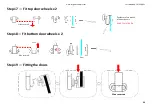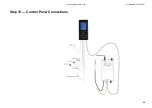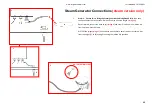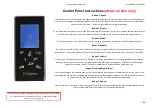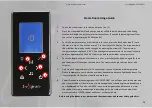
www.insigniashowers.com
Last Modified: 20/09/2021
41
There are 3 bathroom electrical zones that have been distinguished in the IEE wiring guidelines and these are:
Zone 0
is the area inside a bath, basin or shower. It's characterised as 'any area within a bathroom that can hold water'. Any fitting or electrical appliance
utilised inside zone 0 must be a maximum of 12 volts (SELV) and completely secured against both partial and total submersion in water (minimum of IPX7)
Zone 1
is the region straight above zone 0 to the height of 2.25m from the base of the bath or shower. It covers the width of the shower cabin or length of
the bath. Consider zone 1 to be the
‘
splash zone', where a fitting or electrical appliance is probably going to get exceptionally wet, very rapidly, however
would not be totally immersed in water. Any fitting or electrical appliance inside zone 1 must be IPX4 (splash proof) or have a limit of 12v (SELV) with the
transformer situated past zone 2.
Zone 2
is the area extending to 600mm outside of the bath or shower, be that above or to the sides of each. This is commonly the region which is least
likely to get wet however there is a likelihood for it to be splashed. Any fitting or appliance inside zone 2 has to be IPX4 (splash proof) or have a maximum
of 12v (SELV) with the transformer situated past zone 2.
Outside zones (Beyond Zone 2)
At the point where the size of a bathroom goes past zones 0, 1 and 2, portable electrical appliances can be utilised if their cord length doesn't allow them to
be used in zone 2. For example, a hairdryer can be used in the outside zones provided its extended length doesn't enable it to be used in zone 2. Despite
the fact that installing electrical appliances past zone 2 is allowed without an IP number, it is recommended that electrical appliances have some type of
protection from moisture.
The Ingress Protection or IP number denotes the amount of mechanical and moisture protection an electrical appliance has. The
‘
IP
’
notation is followed by
2 numbers that show a numerical degree of mechanical and moisture protection.
The higher the number, the better the assurance it has against moisture/damage. If an appliance does not have an IP number it should never be used in
zones 0,1,2 or anywhere that has a wet or damp environment.
All electrical circuits inside a bathroom must be protected by an RCD (residual current device), commonly known as a circuit breaker, not surpassing 30mA.
RCD
’
s ascertain when an electric current is not functioning normally and break the flow of the current if necessary, to guarantee that you are safe whilst
using it.
Precaution should always be taken when introducing any electric appliance into a bathroom. We always advise using a registered bathroom fitter or
electrician.
*The information on this page is for guidance only and you should always refer to the current IEE regulations of a qualified fitter or electrician to guarantee you are aware if the
latest regulations and codes of practice.
Summary of Contents for 1050
Page 6: ...www insigniashowers com Last Modified 20 09 2021 06 ...
Page 20: ...www insigniashowers com Last Modified 20 09 2021 20 Step 10 Connecting the right side panel ...
Page 24: ...www insigniashowers com Last Modified 20 09 2021 24 Step 13 Connecting the roof 1 ST8 x4 ...
Page 40: ...www insigniashowers com Last Modified 20 09 2021 40 Bathroom Electrical Zones ...
Page 43: ...www insigniashowers com Last Modified 20 09 2021 43 ...


